Dear reader: This article contains links to products and services that I may be compensated for, at no extra cost to you.
So you’re heading on a Mt. Fuji day trip from Tokyo? With only one day, you may need a bit of luck to get a clear view of the elusive mountain. But not all hope is lost, as there are many other great things to do in Mt. Fuji area, whether you get clear views of not.
With limited time, you’ll want to come armed with a good Mount Fuji day trip itinerary. Below I will detail five awesome and totally different Mt. Fuji day trip ideas, because different people have different ways to travel, right? If you most important concern is seeing Japan’s most iconic mountain from the best spots, check out my article on the 10 best Mount Fuji viewpoints!
For this article, I’ve focused on the Fuji Five Lakes area, where the best places to see Mount Fuji can be found. Hakone, which is a little further away from the mountain, also offers great Fuji views when skies are clear. See this other article for more info on a Hakone day trip from Tokyo.
If you end up deciding to stay at Mount Fuji for more than just one day (I would strongly recommend it!) then I’ll recommend some accommodation options below, including this amazing traditional minshuku that I stayed in with a view of Mt. Fuji right in front of it.
At the end, I’ll also cover how to get to Mt. Fuji from Tokyo or from destinations to the south, such as Osaka and Kyoto.
Besides Mount Fuji, don’t miss Kamakura, another great day trip from Tokyo.
Also see my cherry blossoms guide to Osaka, autumn foliage guide to Kyoto, and best places to see in Japan in winter.
Table of Contents
Getting to Mt. Fuji
– I’ll be recommending several tours from Klook, my preferred provider of small group tours. You can get a free credit in your account if you sing up with this link!
– Book a discounted Japan SIM card or an Unlimited WiFi Device before you arrive in Japan. You’ll definitely want Internet access for finding your way around!
– I recommend using 12Go for buying individual bus and train tickets to the Mt. Fuji area.
– The Fujikyuko retro-style sightseeing buses are the best way to get around the Mount Fuji region.
– Want to travel in absolute comfort? Charter a car for the day from Tokyo!
Idea 1: Mt. Fuji Day Tour from Tokyo

Maybe you don’t want to figure out all the planning & buses by yourself. Or perhaps you want to eliminate stress about missing your bus back to Tokyo. Then taking a Mount Fuji day tour from Tokyo may be the best choice for you!
There are many Mt. Fuji day tours available. They come with a wide variety of different ideas and attractions For example, you can even go skiing on Mt. Fuji on a day trip from Tokyo!
When shopping for your ideal Mount Fuji day tour, keep an eye out for the following activities listed:
Gotemba Premium Outlets Shopping
One of the largest outlet malls in Japan, Gotemba Premium offers great views of Mt. Fuji combined with a modern shopping experience.
Almost all tours, such as this one (classic day tour on GetYourGuide) this one (classic day tour on Klook), this one (tour with onsen experience), this one (with stop at Chureito Pagoda), this one (with Fuji 5th station), and this one (Hakone and Fuji tour) include a shopping stop there.
If you want a Mount Fuji day tour with NO SHOPPING, try this one.
Mt. Fuji Ropeway
The Mt. Fuji Panoramic Ropeway (formerly called Kachi Kachi Cable Car) ascends 400 meters to the top of Mount Tenjo for epic views of Mt. Fuji and Lake Kawaguchiko. The cable car is named after a folk story about a rabbit and a tanuki (Japanese raccoon), so you’ll see lots of imagery relating to the two animals up there.
The Mt. Fuji Ropeway is included on this tour and this tour.
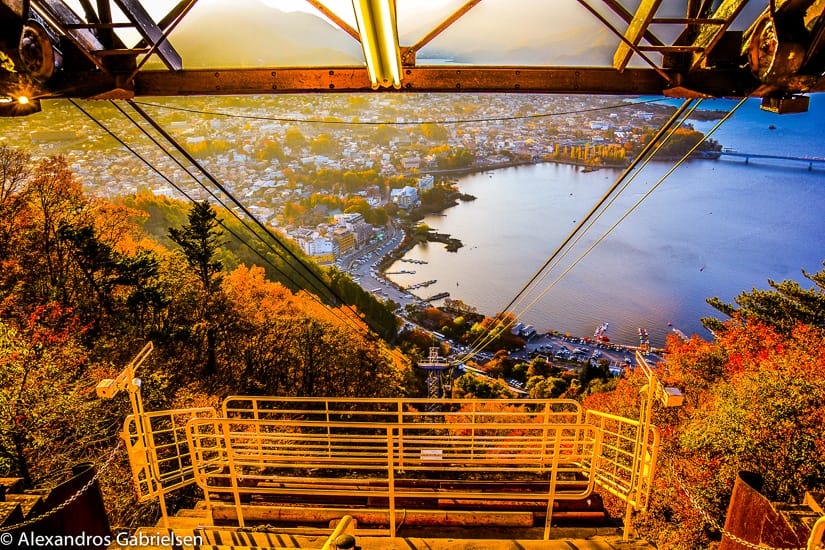
Oshino Hakkai
In this tourist’s village, eight scenic ponds are surrounded with traditional Japanese farmhouses, with Mount Fuji views dominating the background. It is located in Oshino, a small village between Lake Kawaguchi and Lake Yamanaka.
Oshino Hakkai is included on this tour, this one, and this one.
Fuji 5th Station
Fuji 5th station lies about halfway between the traditional starting point of the Mount Fuji climb at Fuji Sengen shrine and the peak of Mount Fuji.
The village is accessible almost year-round, and offers both stunning views of the peak of Mount Fuji and down to the Fuji Five Lakes. Fuji 5th station is included on many tours, including this one and this one.
Chureito Pagoda
This shrine is most famous for having what is perhaps the single most famous view of Mount Fuji, from behind Chureito Pagoda.
Chureito Pagoda is included on this tour.
Love temples? Check out my articles on staying at a temple in Koyasan and the impressive Kumano Sanzan temples in Wakayama
Idea 2: Mt. Fuji Adventure Day Trip
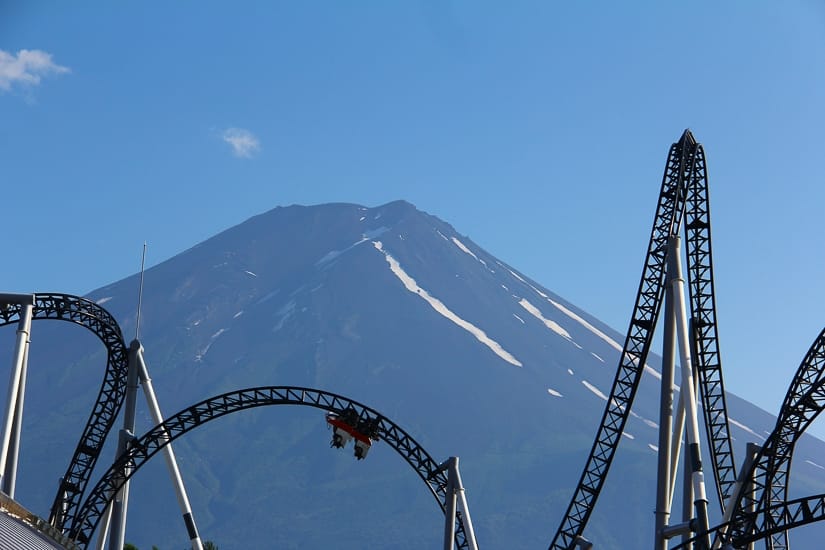
For thrill seekers, here’s a Mt. Fuji itinerary for you. This large amusement park sits very close to the base of Mt. Fuji, offering the chance to see one of the world’s most famous mountains from the top of a roller coaster!
Start your day by heading directly to Fuji Q Highland. This deal includes transfer from Tokyo and entrance tickets. Or get there on your own by booking your transportation on 12Go, then get a discounted admission ticket here.
Some of the most awesome rides in the park include 79-meter Fujiyama, the world’s 8th tallest, 5th longest, and 10th fastest roller coaster, Dododonpa a shorter but even faster roller coaster, Eejanaika, a “4th dimension” roller coaster, and Takabisha, the world’s steepest roller coaster. There are are several haunted attractions, a Ferris wheel, and rides where you get wet.
There is even an onsen (¥1,400 weekdays/¥1,700 weekends, only ¥620 7-9 am) beside Fuji Q, with a view of Mt. Fuji from the relaxation area. There also many restaurants inside Fuji Q to choose from for lunch.
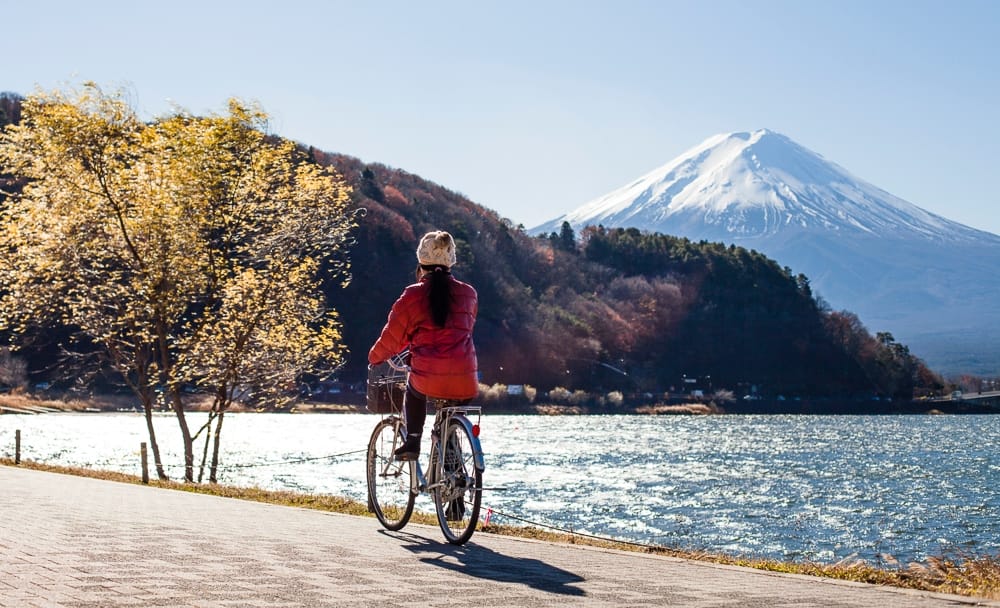
After you’ve had your fill of rides (and lunch), hop on the Fujikyuko bus to Mt. Fuji Yamanakako station (40 minutes) and hire a bicycle (¥1500 for the day) to ride on the dedicated cycling path around the lake, taking in incredible Fuji views along the way.
At the end of your ride, go for a soak in Onsen Benifuji No Yu (10 am to 9 pm, from 6 am on weekends and in winter, ¥700), a (nude only) hot spring which offers Mt. Fuji views. Visitors with tattoos may not be allowed.
Make sure to book your return ride back to Tokyo, and don’t miss the last one!
When it Tokyo, don’t miss the geeky attractions of Akihabara district!
Idea 3: Explore Kawaguchiko
Kawaguchiko, or Lake Kawaguchi, is the most famous and visited of the Fuji Five Lakes. The train station and bus station are located about 10 minute’s walk from the south side of the lake, while postcard-worthy Mt. Fuji views can be enjoyed from the north side.
After traveling from Tokyo to Kawaguchiko, the red line of the Fujikyuko sightseeing bus departs from Kawaguchiko station to all the below sights. It is also possible to ride a bike or walk between many of them.
Start by taking the the bus (11 minutes) to stop #9 or walking (15 minutes) to the Mt. Fuji Panoramic Ropeway for epic Fuji views from the summit of Mt. Tenjo.
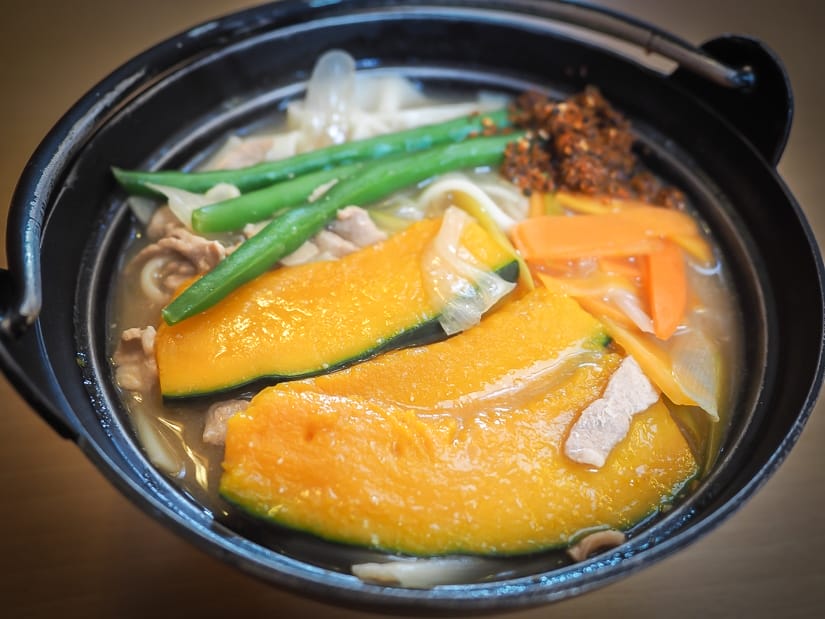
For lunch, take the bus to stop #15 (called “Kawaguchiko Music Forest Museum stop”). Go to Houto-Labo or Houtou Fudou for a lunch of “hoto”. This is a Yamanashi/Mount Fuji specialty that consists of thick udon noodles in a miso broth with pumpkin. Both restaurants are within walking distance of the bus stop.
Nearby, you can also pop into the Kawaguchiko Museum of Art (¥800, open 9:30-5), which houses a large collection of Fuji-related artworks, or the somewhat unusual Kawaguchiko Music Forest Museum (¥1,500), a musical theme park at the lakeside, which the bus stop is named after.
Another worthwhile stop is Kubota Itchiku Art Museum (stop #17), dedicated to a master of silk dying. On display you can see his unfinished masterpiece, an image of Mount Fuji made up of 80 kimonos. The museum is surrounded by lovely woods. Make sure to check whether it’s open before you go.
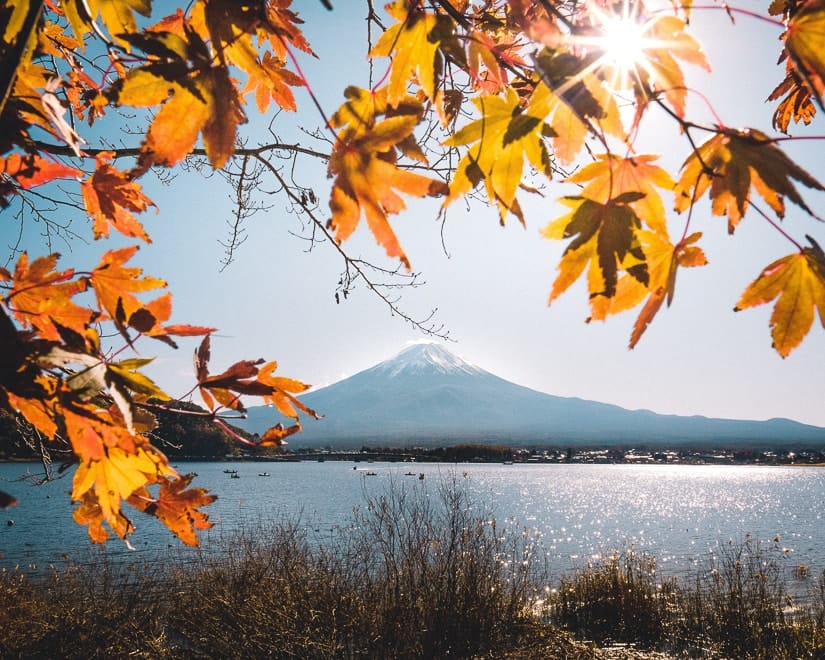
Nearby, the Maple Corridor is a must if you happen to visiting in autumn, while Nagasaki Park (stop #18) offers some of the finest Fuji views on this side of the lake.
If you continue to the end of the bus line (stop #20), Kawaguchiko Natural Living Center features lakeside gardens, fruit picking, and jam making.
Hey day-trippers, here are 40 awesome day-trip ideas from Taipei, Taiwan!
Idea 4: Sacred Sights & Culture
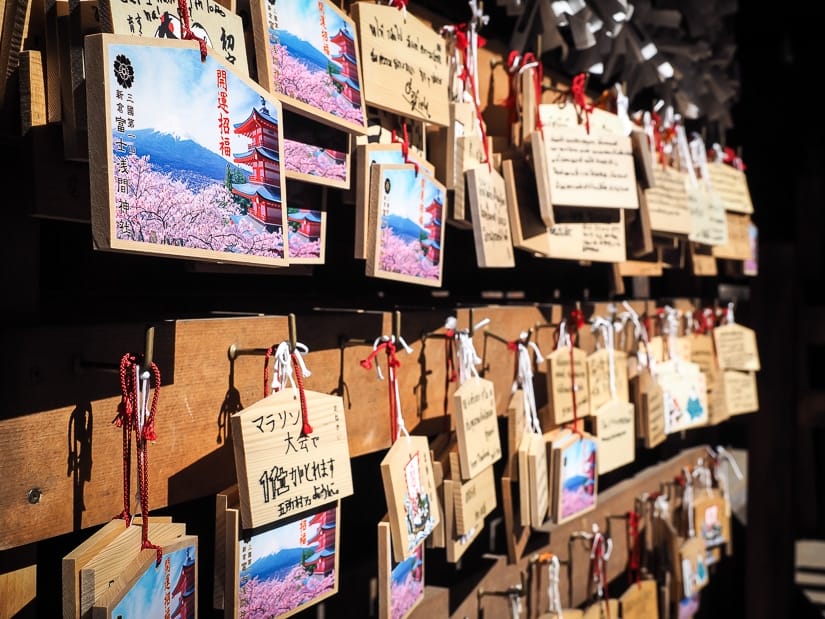
Mount Fuji is sacred to the Japanese. Since ancient times, it has been a Shinto pilgrimage site, a source of artistic inspiration, and a center of training for ascetic Buddhism. Today, there are more than 1000 Fuji Sengen shrines across Japan, which are dedicated to Princess Konohanasakuya, the deity associated with Mt. Fuji.
If you are interested in Mount Fuji’s spiritual connections, you should plan your Mt. Fuji day trip itinerary around visiting some of its most important temples.
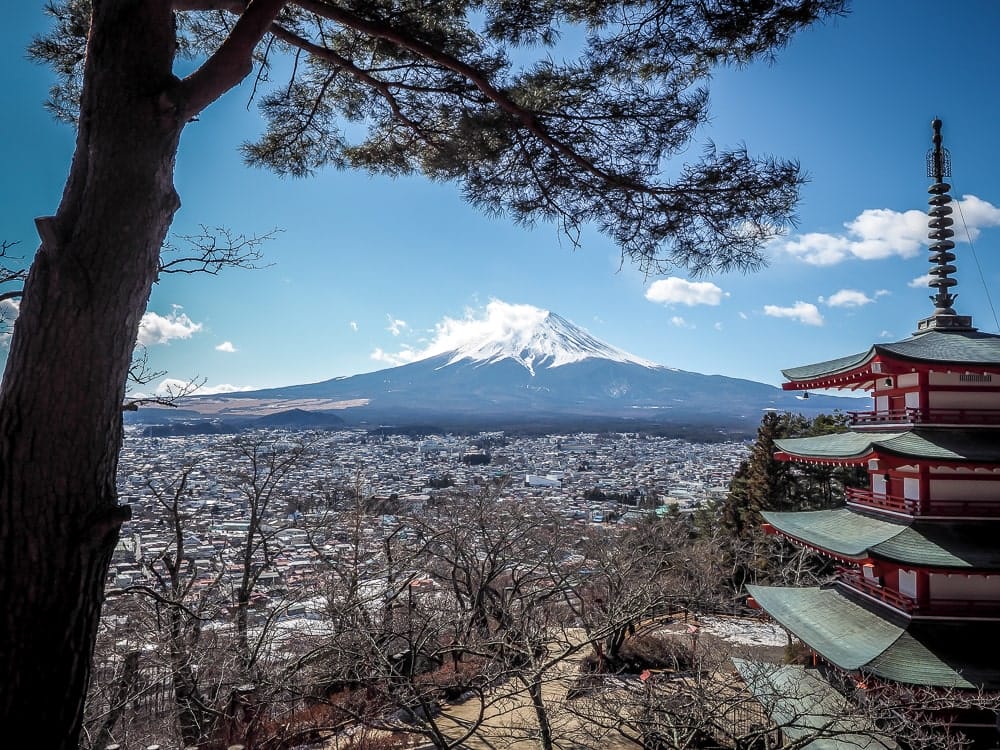
Since Mt. Fuji is usually best seen in the morning, try to take one of the earliest buses from Tokyo to Kawaguchiko.
Start your day by heading to Arakura Sengen Shrine (sometimes called Kawaguchi Sengen Shrine), pictured above. While the shrine itself is peaceful and worth a look, most people come for Chureito Pagoda, where one of Japan’s most iconic views can be enjoyed.
A trail of 398 steps lead to a position behind the pagoda with an unbeatable view of Mt. Fuji. Come in mid-April to add cherry blossoms to your shot, but be prepared for some serious crowds!
To reach Arakura Sengen Shrine, you’ll need to catch the train from Kawaguchiko to Shimo-Yoshida Station (10 minutes, ¥300). From there it’s a 10-minute walk, plus however long it takes you to get up those steps! If you don’t want to go through the transportation trouble, you can visit this pagoda on this organized day tour.
If you are interested in spiritual places, see my articles on hiking the Kumano Kodo pilgrimage and soaking in the sacred hot springs of Wakayama.
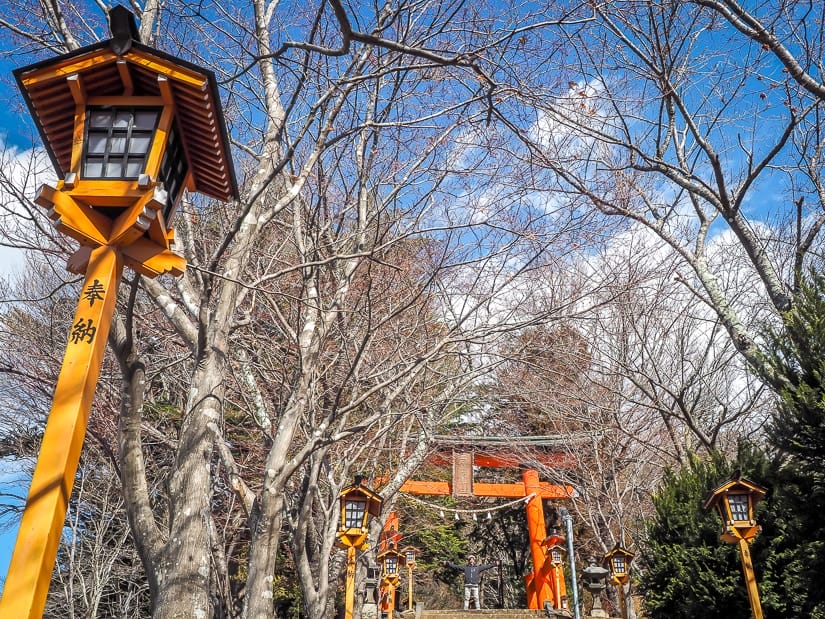
Next on your itinerary, hop on the train from Shimo-Yoshida Station to Fujisan Station (¥219, 6 minutes) to reach the second stop, Fuji Sengen-jinja Shrine (also known as Fujiyoshida Sengen Shrine or Kitaguchi Hongu Sengen Jinja).
The shrine is a 30-minute uphill walk from Fujisan train station. For lunch, you can try Musashi Udon along the way.
You an also get there in 20/10 minutes from Kawaguchiko/Fujisan station on the the Yamanaka Fujikyuko bus (stop at Kitaguchi Hongu Fujisengen Jinja-mae).
Besides these train + walking/busing options, you can hop on the World Heritage Loop bus from Arakura Sengen Shrine all the way to Fuji Sengen-jinja Shrine (30 minutes), but note that this bus doesn’t run from December 1 to March 31.
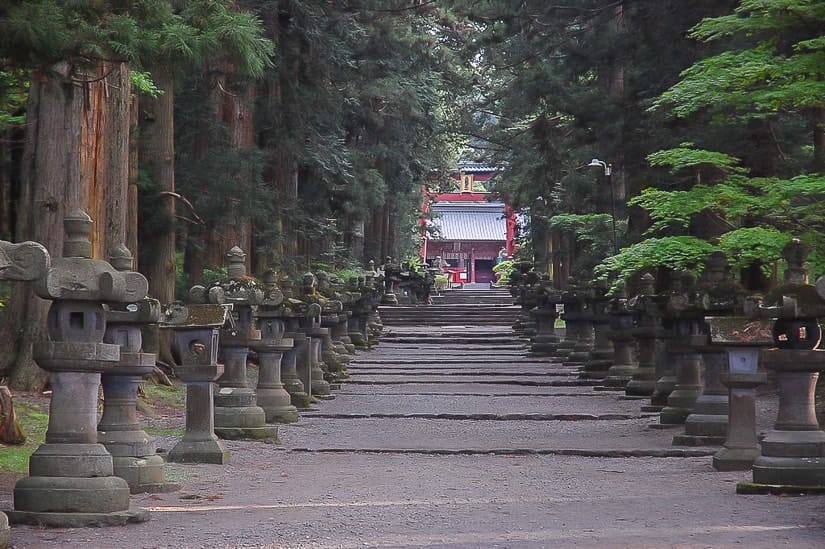
Fuji Sengen-jinja Shrine is the second most important of the three sengen shrines in the Mt. Fuji area (the most important is Fujisan Hongu Sengen Taisha on the other side of Mt. Fuji, but that’s a little too far to include on this Mt. Fuji 1 day itinerary!)
Fuji Sengen-jinja Shrine is also the historical starting point of the hike to the summit of Mt. Fuji from the north, so visiting here is an appropriate inclusion on your Mt. Fuji explorations. From the moment you enter via the long approach from the main road through a cedar forest, you will sense you are in sacred territory.
If you want to see the official start of the hike up to the peak of Mt. Fuji, you can find it to the right behind the main hall, although most hikers nowadays start halfway up the mountain at Fuji 5th Station.
From Fuji Sengen-jinja Shrine, you can also walk (15 minutes) to another smaller forest shrine called Arayayama Shrine, a quiet place dedicated to the god of economic fortune.
Finish your day by hoping back on the Yamanakako bound Fujikyuko bus and heading to Oshino Ninja Village (9am-5pm, ¥1800), and/or Oshino Hakkai (24 hours, museum 9am-5pm, ¥300) where you can learn about traditional local culture.
For a less touristy option, head to the northeast shore of Lake Kawaguchiko and find your way to Kawaguchiko Asama Shrine, a secluded shrine with an 18-meter Otorii (traditional gate) at the entrance and surrounded by 1200-year-old cedars.
Idea 5: Off-the-Beaten Track & Nature
If you prefer to escape the tourist crowds and get into nature, then this Mt. Fuji day trip option is for you. You’ll want to to catch an early ride to Kawaguchiko if you plan to squeeze the below itinerary into one day. Otherwise, you might have to skip a few stops, and make sure to keep an eye on those bus times if you need to get back to Kawaguchiko for your ride back to Tokyo.
For Kawaguchiko Station, hop on the Fujikyuko bus blue line to Koyo-Dai Entrance stop (27 minutes), which is one stop before Narusawa Hyoketsu (Ice Cave) and two stops before Fugaku Fuketsu (Wind Cave) stops.
From the bus stop, a small road runs north off the highway, which you can follow all the way to the peaks of three mountain-top lookout points with incredible views of Mt. Fuji and the Five Lakes: Koyo-Dai (1165m), Sanko-Dai (1202m), and Goko-Dai (1355m).
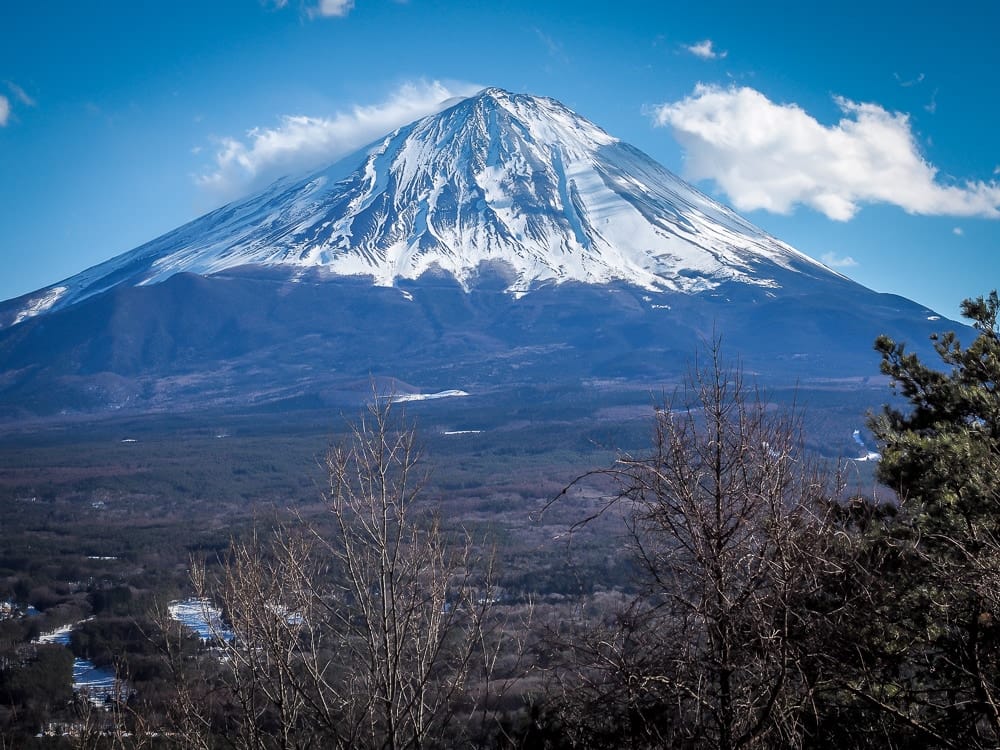
The road and trails are an easy but very rewarding hike, and can even be done in winter (as I did). You can budget an hour return for Koyo-Dai, where you’ll find a small café (closed when I visited) with a lookout platform.
It’s only another 10 minutes up from there to an even better viewpoint at Sanko-Dai (see the cover image of this article), where you can see three of the Fuji Five Lakes.

You’ll need about three hours return to make it all the way to Goko-Dai and back to the highway, but you’ll be rewarded with a view of all five lakes at the same time.
If you want to visit the other spots on this itinerary, I’d suggest sticking to Koyo-Dai and Sanko-Dai, which should take no more than 1.5 hours return.
Next, walk or take the bus one stop to Narusawa Hyoketsu (Ice Cave). After visiting the cave, you can follow a pretty trail (30 minutes) through the forest to similar Fugaku Fuketsu (Wind Cave), or hop on the bus for one stop.
The two caves were formed by molten lava when a flank volcano of Mt. Fuji erupted in the year 864. Both of them contain awesome tunnels, ice walls, ice pillars, and more, and have even been used to store silk worms.
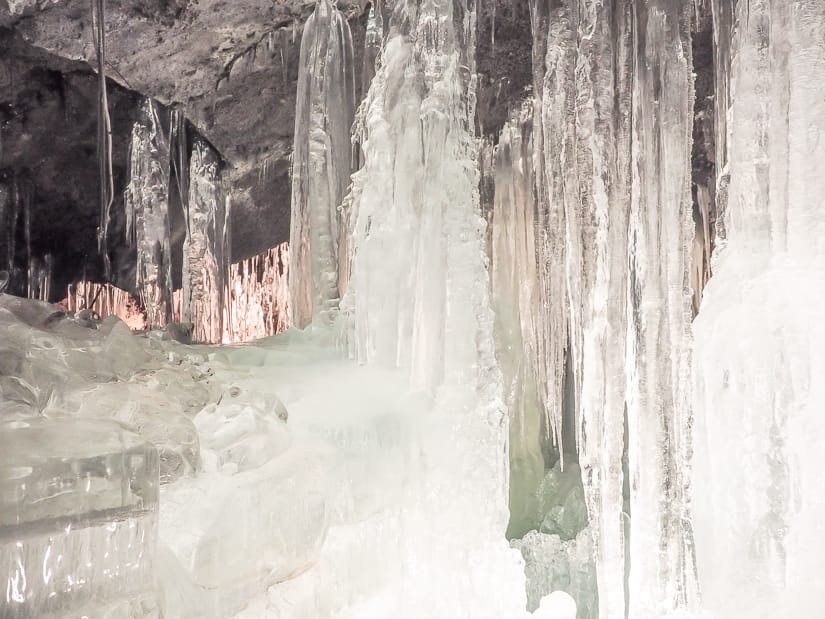
See more information on the website for the two caves, and note that there is a combined ticket if you plan to visit both.
From the Wind Cave, you can catch the green line of the sightseeing bus to remote Lai Sai (Saiko), where you can visit Iyashi no Sato, a reconstructed traditional village with views of Fuji forming the background to Edo-era houses, which is a similar but less touristy version of Oshino Hakkai between Kawaguchiko and Yamanakako lakes.
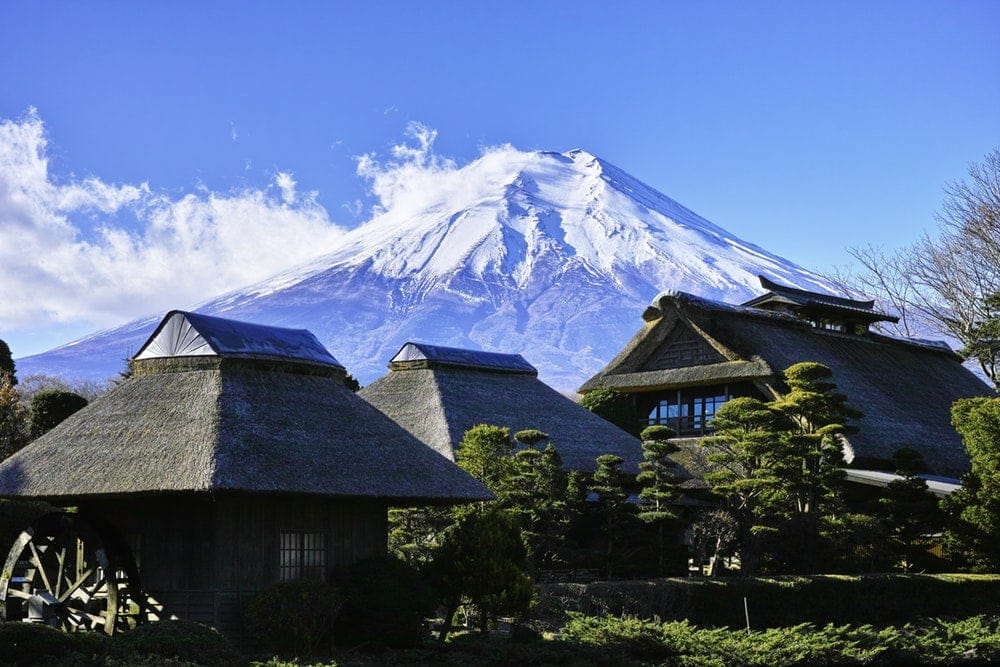
Another choice is to continue along the blue bus line to remote Lake Shoji (Shojiko), which some say (and I personally agree) has the most beautiful Mt. Fuji views out of all the Fuji Five Lakes.
Get off at Kodaki Fuji View Point for the ultimate Fuji view. But beware; the last bus back from here to Kawaguchiko departs at 4:35 p.m, so if you want to see the sunset and get a shot like the one below, you’ll have to spend the night!
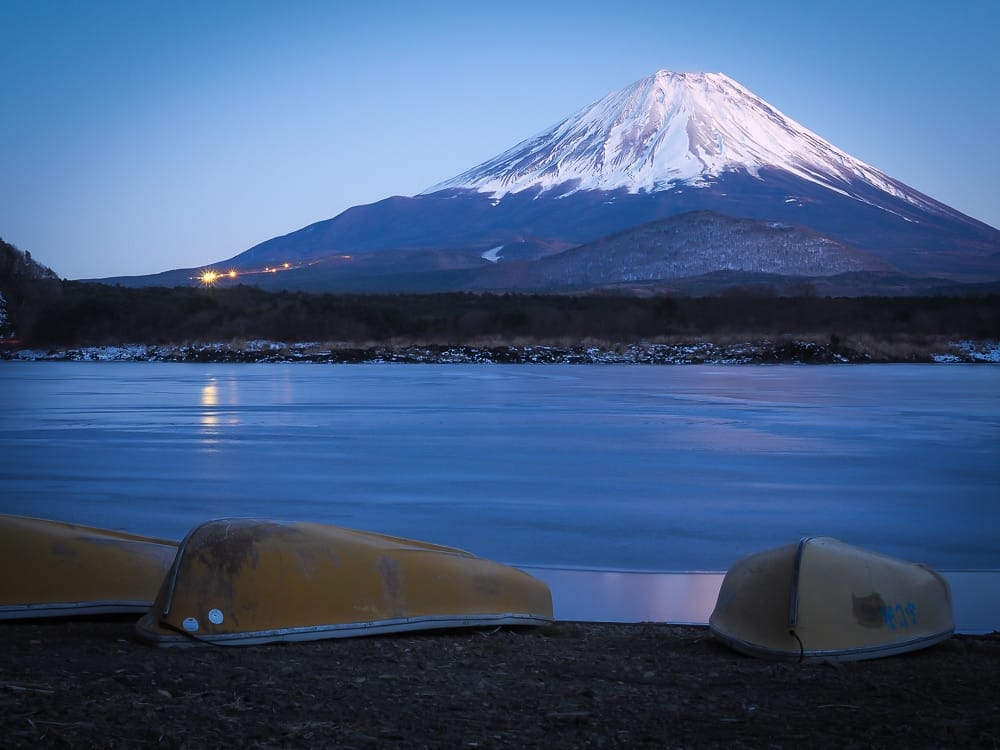
Lake Shoji is actually where I based myself when I visited the Mount Fuji region. There are only a few hotels on the entire lake, so it feels very unspoiled, and the scenery couldn’t be more beautiful. On top of that, the guesthouse where I stayed, Minshuku Murahamasou was the best traditional Japanese guesthouse I’ve ever stayed in.
The food was beyond incredible, and I truly felt I was being taken care of by my (Japanese) mother. The hosts’ American daughter in law was also available by email to answer all my questions in English before I arrived.
So if you end up getting stuck in Shojiko, or you decide to make your day trip to Mount Fuji and overnighter (and you love avoiding the tourist crowds), I can’t recommend this place enough!
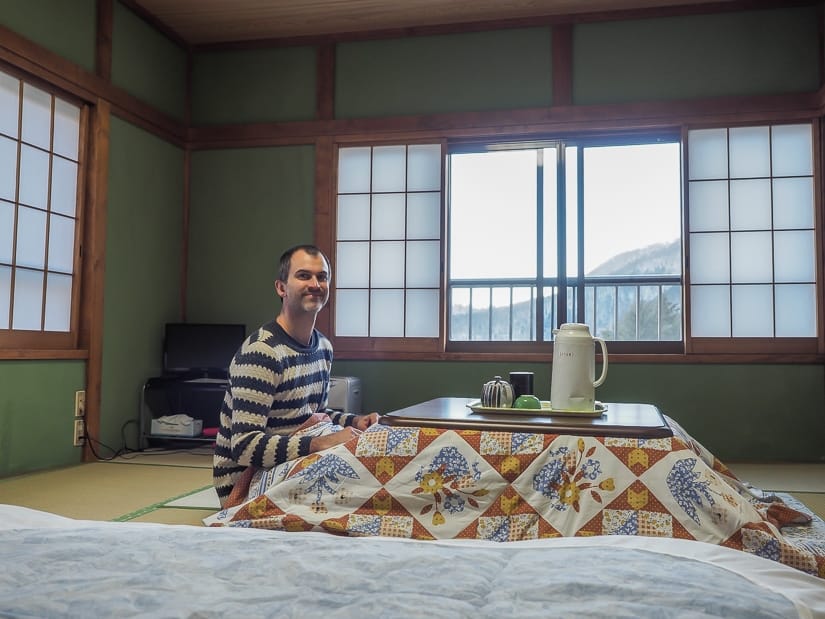
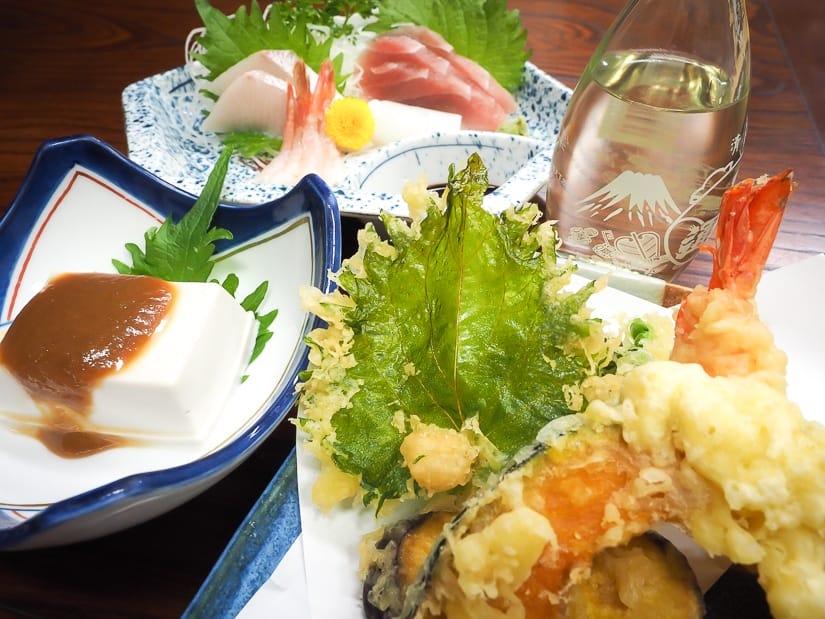
It would be tough to squeeze it into a one day itinerary for Mt. Fuji, but past Shoji Lake, the same bus (the blue line) also reaches the entrance to Motosuko (Motosu Lake). From the bus stop at the entrance, you can walk (two hours return) to the famous 1000-Yen Viewpoint of Mt Fuji, pictured on the 1000-yen banknote.
There’s no walking path; you just have to walk along the highway, so I would only recommend this for people who REALLY want to see that view or are staying in the area longer.
Getting from Tokyo to Mount Fuji
Buses are the fastest and most convenient option for getting from Tokyo to Mount Fuji. The bus from Shinjuku or Shibuya station takes 1 hour 45 minutes and costs around ¥2000. It’s best to reserve your tickets online before you go and arrive at the station at least 30 minutes before departure.
If you head back to Tokyo during rush hour, the ride can take up to three hours.
Getting from Osaka to Mount Fuji on the Bullet Train
The Shinkansen (bullet train) travels from Shin-Osaka to Shin-Fuji station, and you can even see Mt. Fuji from the shinkansen as you approach Shin-Fuji station (sit on the left hand side!) What an exciting way to get your first glimpse of Mount Fuji! You can book your Shinkansen tickets here.
From Shin-Fuji station, there are only four buses per day to Mount Fuji, departing at 7:15, 9:45, 11:45, and 13:45. Make sure to time it right! The bus ride takes about two hours to Kawaguchiko, passing lakes Motosuko, Shoji, and the Wind/Ice caves, and you get lots of great Fuji views along the way.
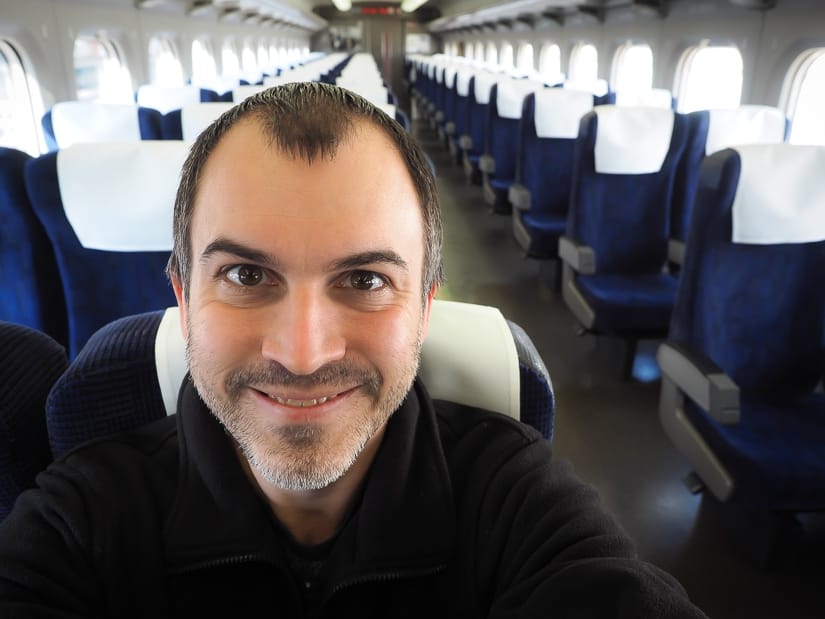
I hope you enjoy your 1 day trip to Mount Fuji, and please let me know in the comments below if you have any comments or questions!


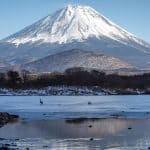
Hello,
I would like to know if it is possible to go from Mont Fuji directly to Kyoto? What is the fastest way? Where does it start?
Thank you a lot
Hi Jennifer,
You can take the shinkansen from Kyoto to Shin Fuji Station. There’s actually a great view of Mt. Fuji from the station! Then take the bus to the Fuji 5 Lakes area. There are only 4 buses per day (last one 13:45), so make sure you get there early enough!
https://bus-en.fujikyu.co.jp/pdf/rosen/timetable_shinfuji_201906.pdf
Hi Nick! Thank you so much for sharing these off-beaten guides, very informative. Question, do we need a guide in trekking the 3 peaks? We are hikers so planning to trek it on our own if trails are well marked. Thanks in advance!
Hi Mary Ann! Thanks for your comment, and I’m glad you were able to find some useful info here. Unfortunately, I haven’t personally trekked to any of these peaks, so I can’t say for sure whether a guide is necessary. I hope you are are able to find reliable info from someone who has!
Hi Nick!
Thank you for this awesome guide for exploring Mt.Fuji. I would like to ask how much is the room rate of Minshuku Murahamasou? I have emailed them but still got no reply.
Thann you so much
Hi there, you can find their room rates on their website: https://www.murahamasou.com/guestroom.html
Their contact information is also on there. Sorry that I cannot help you further than that!
Hi Nick
We are staying in Hakone, can you advise the best way to get to get to do Mishima Skywalk and Lake Kawaguchi from there. We are open to the option of staying closer for the night.
Hi Belinda,
I’m sorry that I haven’t personally been to Mishima Skywalk or traveled from Hakone to Kawaguchiko. I hope you find the info you are looking for!
Hello Nick!
Thank you for such an informative blog.
Wondering if Highland Fuji Q and Lake Kawaguchiko (cable car and ship cruise) is doable for a day trip?
Thank you kindly,
Leah
Sure, I think it’s possible if you get an early start to your day. You can spend 2-3 hours at Fuji Q, budget about 1 hour for the cable car, and still time to fit in a ship cruise as well.
Hello Nick!
Thank you for such an informative blog.